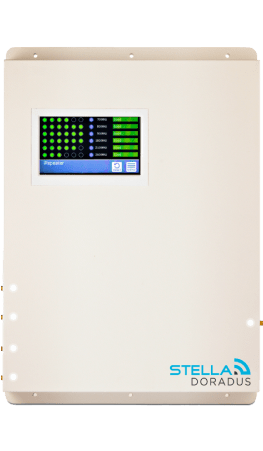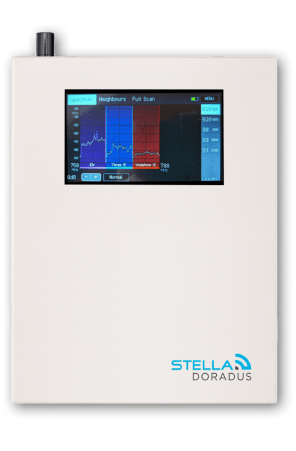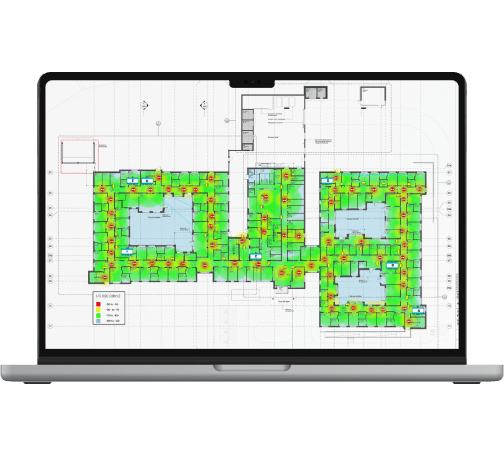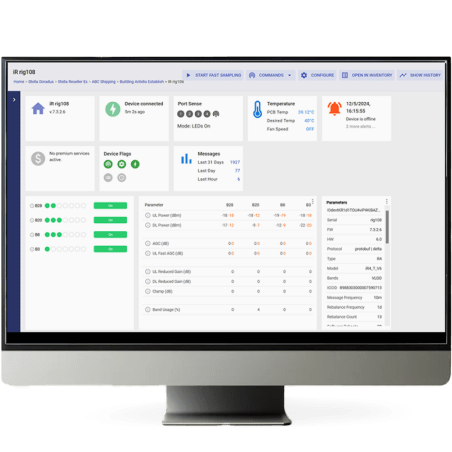FAQs
General
Are all repeaters the same?
No. The two defining parameters of a repeater are its frequency and coverage capability. The operators use different frequencies for 2G, 4G and 5G, and buildings vary a lot with regard to size and location. Here, at Stella Doradus, we have designed a complete range of repeaters, with signal coverage solutions to suit every budget and building requirement, ensuring customers are fully satisfied.
What is the difference between a signal booster and a repeater?
There is no real difference between the 2 terms.
What is StellaControl?
The StellaControl RMS is a web-based platform that provides installers and authorized users remote monitoring, managing, and control of repeater installations.
Is cellular radiation dangerous for your health?
This is a question that is often asked and the short answer is no. There is no proof (after 30 years of that a mobile phone which is often up against your head causes any ill effect. Furthermore, a repeater outputs 50 – 100 times less power than a mobile phone, due to its distance to the user, so it is of even less of a concern.
What is the StellaPlanner?
The StellaPlanner is our online repeater planning tool. It allows you to upload .PDF plans of your building, place antennas and repeaters where you see fit, and pre-design your installation in the most efficient way. You can then download the .PDF plans for your reports.
What is the TestTool?
The TestTool is a cellular signal survey tool designed by Stella Doradus especially for repeater installations. It has 2 main modes, Spectrum analyser and Cells mode. It can do automatic surveys and sync the data directly to your StellaControl account.
What is the benefit of the Titan repeater?
The Titan repeater has increased gain, up to 65dB. It also has an embedded cellular modem which auto connects to StellaControl RMS on startup, for remote monitoring. Remote scans can also be conducted, which allow you to study and understand the signal outside the building.
What is PortSense?
PortSense (patent pending), is a new feature whereby all the cables, connectors and antennas in the system are automatically and continuously tested for any faults. If there are no faults, a white LED turns on inside the antenna and on the repeater itself. This gives the installer confidence that he/she has done everything correctly. PortSense can also be viewed remotely on StellaControl.
Are Stella Doradus repeaters fully compliant with EU/UK regulations?
Yes. Our broadband repeaters are fully legal across the EU, UK and Ireland. They pass all the required European Radio Equipment Directives, (RED) and Ofcom/Comreg specifications.
Will Stella Doradus repeaters amplify 5G?
Yes. 5G is transmitted at 700MHz and 2100MHz in most countries. Stella repeaters amplify these bands and so you will have 5G amplified into your building with our repeaters.
Installation
Why do I lose mobile phone signal indoors?
The farther you are away from the cell tower, the weaker the signal. Furthermore, hills, trees, walls, metal foil insulation and triple glazed windows in buildings all reduce mobile signal to differing degrees.
What frequency repeater do I need?
For homes and small offices, we recommend the SOHO-R4. This amplifies 4 cellular bands giving strong connectivity and redundancy. For larger buildings, we recommend the Titan range.
What are the best signal analysers (best tools) for repeater installations?
- TestTool analyser. Use our TestTool, which we have designed specifically for installers of repeaters. It auto connects to our online monitoring platorm StellaControl, and allows you to do extensive surveys, produce beautifull heat maps, and ensures the optimal installation is achieved.
- iRepeater – an iRepeater can be used to record the outdoor signal strength on the roof of the building. This information is automatically sent to StellaControl where it can be analyzed live by experienced Stella engineers.
Warranty & Returns
How will my repeater be delivered?
All orders are shipped via express delivery and are normally delivered within 1-4 business days. Your order will be dispatched directly from our premises and you will be forwarded tracking information for the order after it is dispatched. If you have any questions on your order status, please contact us.
Is Tax removed if I am a business?
There are 2 cases with regards to VAT and business. 1) If you are a business ( hold a valid EU business VAT number), and reside in the same country as your chosen reseller, VAT will be added. However, you can write this VAT off your accounts at the end of year. 2) If you are a business (hold a valid EU business VAT number), and you reside in another EU country to that of the reseller you are buying from, VAT will be removed automatically. Example: You live in Belgium but are buying from a French reseller. In this case, VAT will be deducted from your order.
Is there an extended warranty?
Yes, Up to 7 years of extended warranty is possible. Please contact us about this.
Technical
What are taps? What are splitters?
Splitter: A splitter can be used to introduce a second antenna into the system. However, it adds 3.5dB of attenuation to the signal. The effect of this 3.5dB loss is to effectively shorten the cable. Stella specifies that the length of SD400 cable from the repeater to the internal antenna should be no more than 35m. However, if a 2 way splitter is introduced, the recommended length is reduced to 20m. If a 3 way splitter is used, the length is reduced again to 15m. A splitter adds the same loss, 3.5dB, to both sides of the split.
Tapper: A tapper (tap), is similar to a splitter in that it allows the cable to be split to install a second antenna. however, the loss is not equal on both sides. Instead, one side experiences a loss of 6dB, whereas the other side experiences a loss of 1.3dB. This can be useful when installing several antennas along the same cable. The taps can equalize the signal power to all the antennas, ensuring that the last antenna on the line still has enough power to be effective.
What is Passive DAS?
Passive DAS means: Passive Distributed Antenna System. This essentially means that the primary means by which the mobile signal is propagated around the building is through passive elements such as RF cable, splitters and passive antennas, which use no energy at all. This is by far the simplest, most eco-friendly and cost effective way to achieve mobile coverage within a building.
What is the advantage of multi-band repeater over a single band repeater?
Future Proofed: The more bands the repeater has, the more likely the system will function well in the future. The radio frequency landscape changes all the time. Think of the transitions from 2G to 5G. Limiting yourself to just one frequency means you are less likely to benefit from new improvements that the operators make to their networks as time goes by.
Carrier Aggregation: The more bands the repeater has, the more carrier aggregation (CA) can take place. CA is when the operator combines 2 or more frequency bands to provide the user with much higher bandwidth and data speeds. One of the core technologies of 5G, which enables it to perform at these super high speeds, is CA.
Redundancy: The more bands you have, the more robust your system will be. Even if one band is compromised, which can happen a lot, the phone can still use the other bands.
Covering Natural Signal: It is very important that the “natural signal” in your building is “covered” by the repeater. Mobile phones always try to connect to the highest frequency mobile signal that is available. Lets take an example of a house that has installed a single band 900MHz repeater. If 1800MHz is available in this house, even it it is very weak, the phone will bypass the repeater completely, and connect over the weak 1800Mhz signal. By installing a multi-band repeater you can reduce the chance of this happening. Ideally we would just install a 6 band repeater and not have to think about this. However, the cost is prohibitive for domestic installation, so a dual or tri-band is a good compromise.
What is MIMO?
MIMO refers to Multiple Input, Multiple Output. It refers to a technology that allows the cellular signal to double or quadruple its bandwidth by utilizing multiple parallel data streams at the same time. It achieves this by using a different polarization for each stream of data. A separate antenna is needed for each stream, and the angle of each antenna must be offset from each other to align with its particular polarization. Even within just one frequency band, we can have up to 4 parallel steams of MIMO data. This is a big bandwidth enhancement.
StellaControl Cloud Platform
How to pay for monitoring?
The first year of Monitoring is included. In order to continue having access to the monitoring service a customer has to purchase a monitoring service contract. This is optional. The repeater does not require monitoring and will perform normally without it. Contact Stella Doradus, or your reseller, to purchase monitoring.





